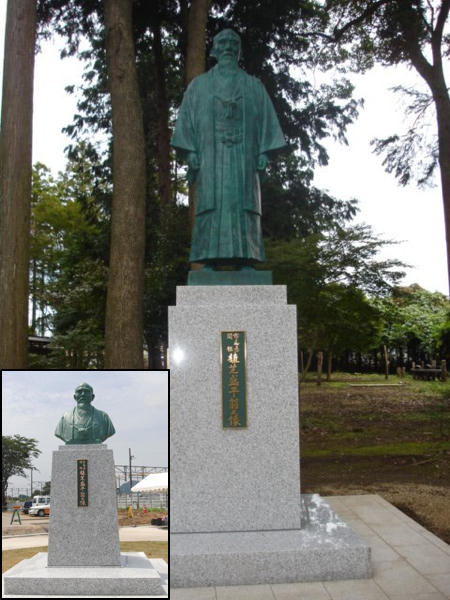
The new statue of O-Sensei in Iwama, and the bust in front of Iwama Station
“The harmony born from the midst of the clash of forces is the real one”
Hiroshi Isoyama sensei was born in 1937, and started training with Aikido Founder Morihei Ueshiba O-Sensei in 1949, at the age of 12.
Isoyama sensei, together with Hiroshi Tada sensei, formed a committee for the construction of a large statue of the Founder of Aikido on the precincts of the Aiki Shrine, which was unveiled on the 8th of November 2009. Surplus material from this monument was used to make a bust of the Founder which was unveiled at the newly rebuilt Iwama Station on the 24th of July 2012.
Hiroshi Tada sensei began Aikido shortly after Isoyama sensei himself – find out how Tada sensei met Morihei Ueshiba in “Aikido Shihan Hiroshi Tada: The Day I Entered Ueshiba Dojo“. There is also a very long interview with Tada sensei in Japanese that appears in a nine part English translation – here is the first part of that interview.
What you are reading now is the second part of a two part English translation of an interview with Hiroshi Isoyama sensei that first appeared in the February 2009 issue of Gekkan Hiden (“Secret Teachings Monthly”), a well known martial arts magazine in Japan. You may want to read the first part of the interview before reading this section.
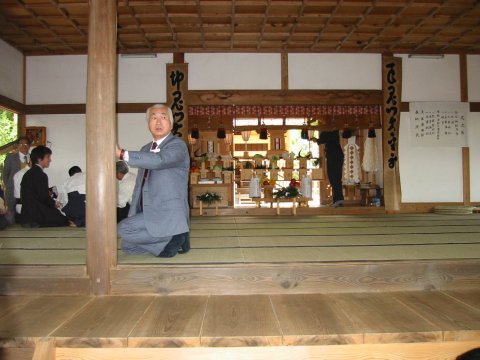
Hiroshi Isoyama sensei inside the Aiki Shrine
May 2002, at the annual Aiki Jinja Taisai
An interview with Aikido Shihan Hiroshi Isoyama, Part 2
(English translation by Christopher Li)
Q: “Connect navel to navel”?
A: Meaning that the end of the hilt is facing your own navel, and the tip is towards your partner’s navel. This develops a firm match between the line of the sword and the center of the body. O-Sensei would become very angry if we crossed swords like they do in the Samurai movies (“chanbara”).
Q: As in how you were striking at each other?
A: Yes, he’d say, “It’s not really that kind of ‘chanbara’. Engage them first with your body, not just your hands.”. When you got used to it you’d find yourself moving the sword with just your hands and running away, but that was no good – you wouldn’t be able to execute a proper Irimi. Connecting with your partner, engaging with the body and entering is the real Irimi. Today most people don’t even pay attention while they’re doing it, but in times past I think that Irimi was serious enough to be called the secret of Budo.
Q: What about swinging the sword upwards?
A: It’s Kokyu. You don’t keep your wrists straight and lift up, you close your armpits and roll your palms inward as you lift up. More quickly than you cut down. This becomes the hands as in Kokyo-ho, and I believe that this connects with everything. I think that O-Sensei must have done quite a bit of research. Also, a great deal of importance was placed on Shiho-nage. If you did Irimi-nage techniques from the beginning you would be scolded.
Q: Why was that?
A: I think that must be because it (Shiho-nage) consist of the basics. There is Tenkan (“turning” / 転換) and Kuzushi (“destabilization” / 崩し), and it is thought that the body is conditioned through that training. In later years (the Founder) liked the soft Irimi, but in our time we began first with Shiho-nage.
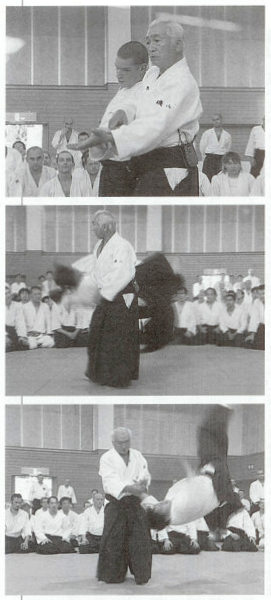
Hiroshi Isoyama sensei teaching Aikido
Unspoken Teachings
Q: Usually when you speak of the Founder he has the image of someone who did not teach, but from what you say it feels as if he taught you quite carefully.
A: He didn’t talk about things in much detail, but he took our hands and taught us conscientiously – this experience is a real treasure.
Q: I have heard that he could be long winded…
A: Yes, sometimes he could be. However, even if he was speaking about the Kojiki he was doing it so that Aikido could be understood, so it was nothing like a long speech about spiritual doctrine. Well, anyway, the talks on the Kojiki were very difficult to understand. (laughing)
Q: Outside of training, were there other things that you noticed while being near the Founder?
A: He was very strict about time. There was one rainy day, it was raining so hard that you couldn’t see more than a meter in front of you, and when the time came for training I was the only one there. I thought “The ground is slippery today, there’s no way that O-Sensei will come”. Taking advantage of this chance, I took out a Shinken (a real sword) that was in the Dojo at the time and started to swing it around.
Q: That must have been a real spectacle! (laughing)
A: As I was doing that, just before the 7:00 practice time, the door opened wide and O-Sensei walked in. I panicked and shouted “I’m sorry!”. (laughing)
Q: (laughing) I’ve heard that the Founder always left in time to make the train before the train that he actually rode!
A: However, whenever I think about it again I think that, rather than being strict about time, it was that he was strict with himself.
Q: Strict with himself?
A: No matter what happens, no matter what the weather is like, always being at practice, never being late – that’s impossible if you are not being strict with yourself. I had to leave Iwama for work to go to Hokkaido, and I taught Aikido to the U.S. military police (“kanpeitai” / 憲兵隊) there. One day there was such a blizzard that I thought “Nobody will show up in this”, and I didn’t go to practice. Later on I heard that they had all showed up after all and waited for me for a long time. It was really inexcusable. At that time I felt the severe presence of the Founder. The Founder never said to anyone “Come on time” or “Don’t miss practice”. But he showed it in his actions. After that, no matter what, I was never late, and if something unavoidable occurred I would always stay in contact. More than just as a Budoka, this is an important teaching for life as a human being.
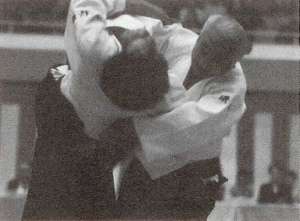
Hiroshi Isoyama sensei demonstrates Irimi Nage
Harmony Born from the Midst of Severity
Q: I’ve heard that you taught the American military’s Green Berets while you were in Hokkaido…
A: Yes, that was just around the time of the Vietnam War, and I taught soldiers who had come to Chitose for training exercises.
Q: I would think that you wouldn’t be able to use ordinary training methods.
A: They were aggressive from the very beginning. The still brought with them the attitude of a victorious nation, when you told them to grab you they wouldn’t listen! They’d say “What do you do if they come like this?”. No matter how severe Aikido training becomes, there is never training in destroying the opponent. However, they weren’t able to understand that. They’d say “If you do that they can escape”.
Q: That’s very difficult, isn’t it?
A: It was hard. That’s why I thought “If I do this half-heartedly then they will look down on Aikido” and prepared myself to push it to the limit with no leniency.
Q: It was like a duel, wasn’t it?
A: Well, everyday it was really like a battle – I started to get tired of it and think “Ahh, I’ve got to go again today…”. When I think of it now, however, it was a good experience.
Q: What were the good points of that experience?
A: However you say it’s like a real battle (“shinken shobu” / 真剣勝負), on this side you are in the teaching position. You can’t just charge ahead recklessly at the same level as your partner. Even if something angers you, or something unexpected occurs you just have to handle it without letting it show on your face. I learned how to move intuitively while exerting that kind of control over myself. Of course it’s important to train with partners who control their temper, but the intuition that is born in the moment that you face the pressure of a partner who is not like that is also an important part of Budo.
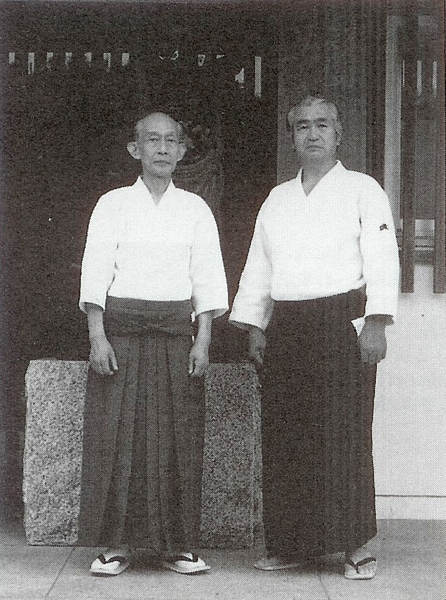
Hiroshi Isoyama sensei with Ni-Dai Doshu Kisshomaru Ueshiba
Q: That must certainly be true.
A: For that reason, when I teach overseas I partner with the local practitioners as much as possible. Large people, small people, strong people, weak people. That is the best way to further my own training.
Q: That’s Shugyo (修行), isn’t it?
A: There is one thing that O-Sensei said that I remember well. When one of the students asked, “Sensei, are today’s Irimi-nage and yesterday’s Irimi-nage different?”, he answered, “Idiot! Aikido is a matter of steady progress.” (日進月歩). I think that is the truth. For myself, when I recall training with O-Sensei, in my junior high school years I can remember nothing but the pain, and in my high school years whether holding a sword or working empty hand the techniques were very severe. This has become transformed to a kind of smoothness as I have reached these later years.
Q: In other words, it is similar to the transformation from “Kaisho” (“block style writing” / 楷書) to “Gyosho” (“semi-cursive style writing” / 行書) to “Sosho” (“cursive style writing” / 草書). Within that range, isn’t Iwama Aikido legendary for its hard training?
A: Rather than “hard”, I would say that it is devoted to basics. However, I myself was not conscious of that transformation occurring – I was surprised when people told me “Isoyama-sensei, you have become rounder”.
Q: You weren’t aware of it at all?
A: Not at all, but I wonder if that is really the truth. When I think about it, in the beginning there was a time when I mistook physical strength (馬鹿力) for Kokyu strength (呼吸力). As the years passed my strength disappeared and I began to use the opponent’s strength to do the same things instead. In other words, Irimi, Tenkan and Tai-sabaki have become natural for me. Thinking in this way, perhaps as one ages it is natural to use strength less wastefully and become closer to the ideal.
Q: On the other hand, some people aim for the ideal of “strength is unnecessary in Aikido” from the very beginning.
A: I think that this is one method. However, doing this without a foundation in the basics will not result in effective techniques, and as Budo I don’t know if this method can result in power in the really important situations. At least, when I am teaching students I say, “Do it with all of your strength. There will come a time when you become aware that you are using your strength wastefully, but until then throw all of your strength into it.”.
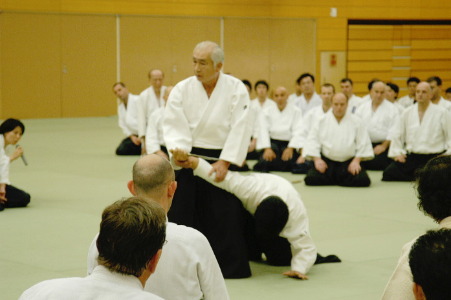
Hiroshi Isoyama sensei teaches at the 9th International Aikido Federation (IAF) Congress
Q: “Using your strength wastefully?”
A: If you fail to exert your strength, even when you are able to, some part of you will remain dissatisfied, and you will stop believing in Aikido. I believe that it is because you have the experience of doing it with all of your strength that you can understand that strength is not necessary.
Q: But when you think about the “Budo of Peace” there must be some place in which you match with your partner, isn’t there?
A: No – conversely, I believe that the harmony born from the midst of the clash of forces is the real one. Isn’t there some part of a “harmony” that is born as the result of giving in that is false? It is especially important to pursue this while you are young. On the other hand, there is no need to do such a stupid thing when you’re sixty or seventy! (laughing)
Q: This isn’t just for Aikido, this is a very important lesson, isn’t it?
A: I think that it is possible to come to understand by doing something wasteful. I think that it’s no good just mimicking outer appearances.
Two Images, Two Glances
Q: Sensei, have you ever thought about quitting Aikido?
A: Of course! I had those thoughts when I was teaching the U.S. military and teaching was not going as I envisioned. I especially had problems when teaching children. However, there have been many more times that I am grateful for. Making many friends through being invited to instruct overseas, good training, delicious Sake. (laughing) That was all thanks to O-Sensei. The experience of applying technique to O-Sensei that I spoke about in the beginning, and all of these experiences, are treasures that I have received from O-Sensei. I cannot keep such treasures for myself alone. For that reason, communicating the experience of O-Sensei to even just one more person through training is my repayment.
Q: What is the image of the Founder that comes first to your mind?
A: There are two. One is inside the Dojo. Sharp, with eyes that judge a person’s heart. The other image is outside the Dojo, a gentle glance. With those two sets of eyes I remain connected to the times of my youth. This is truly the treasure of my life.
Christopher Li – Honolulu, HI

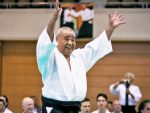
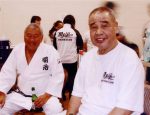

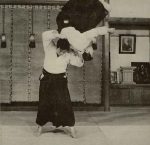
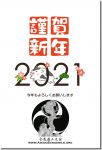

Leave a Reply